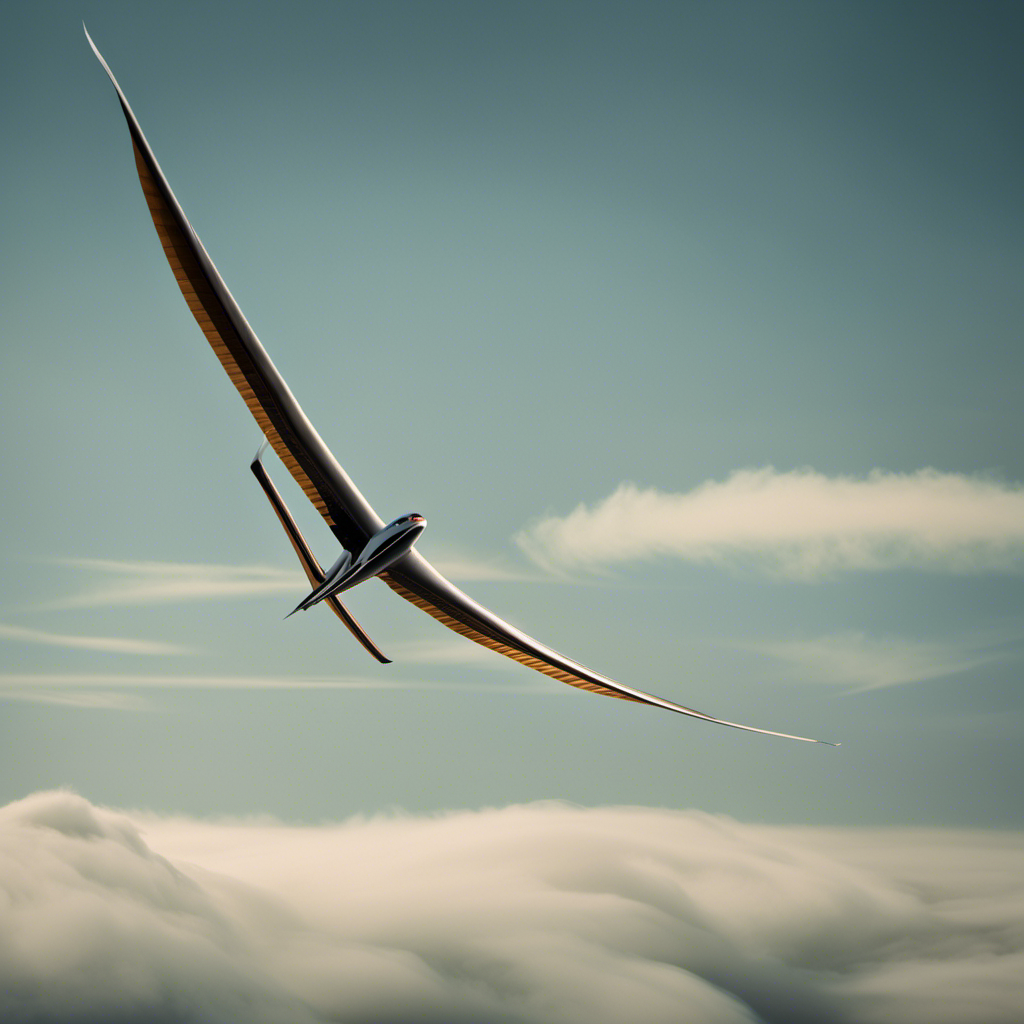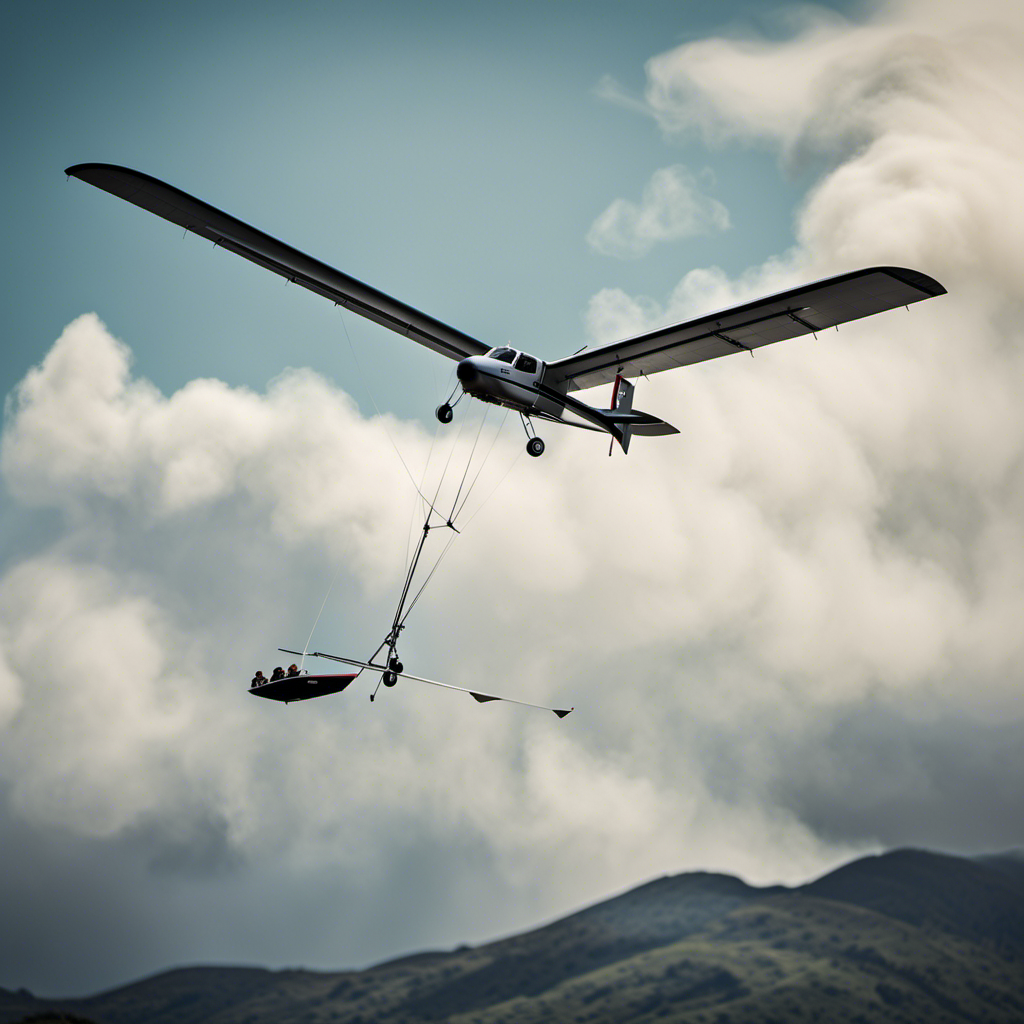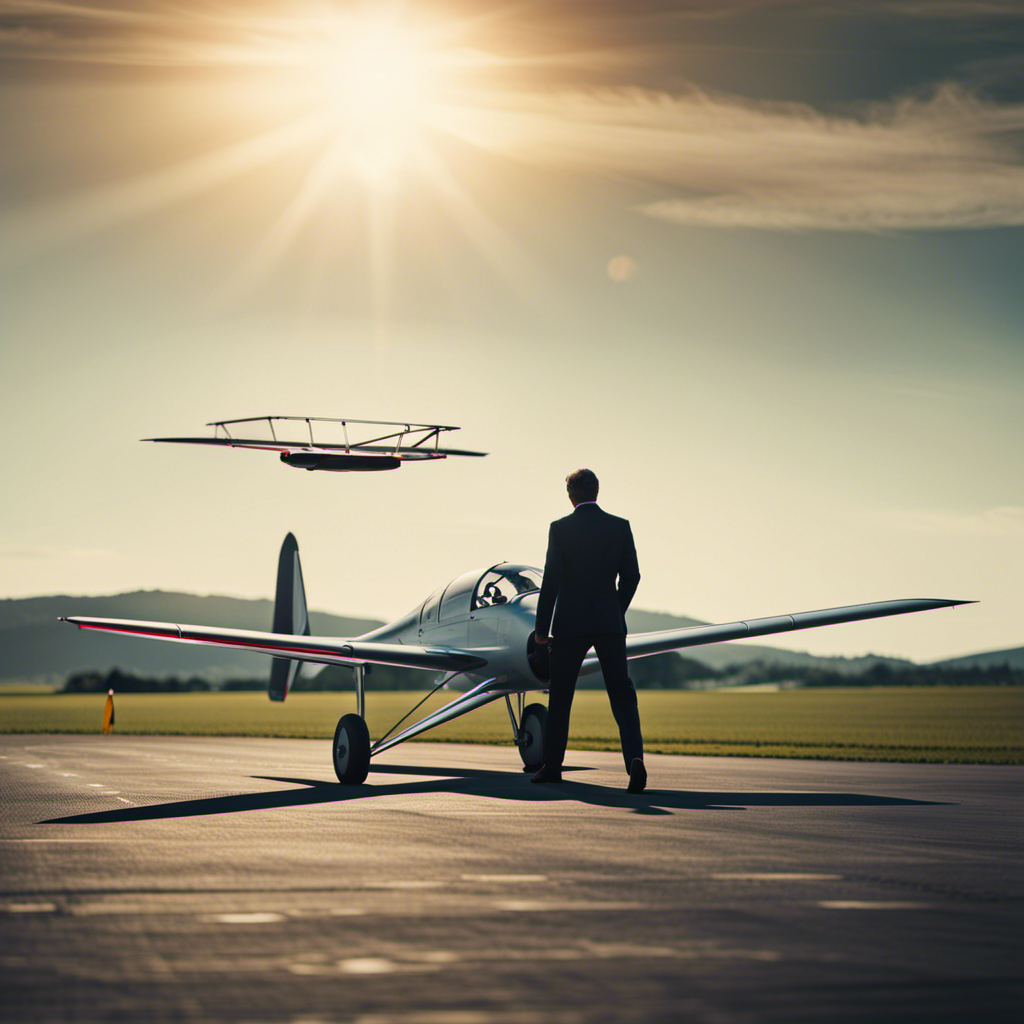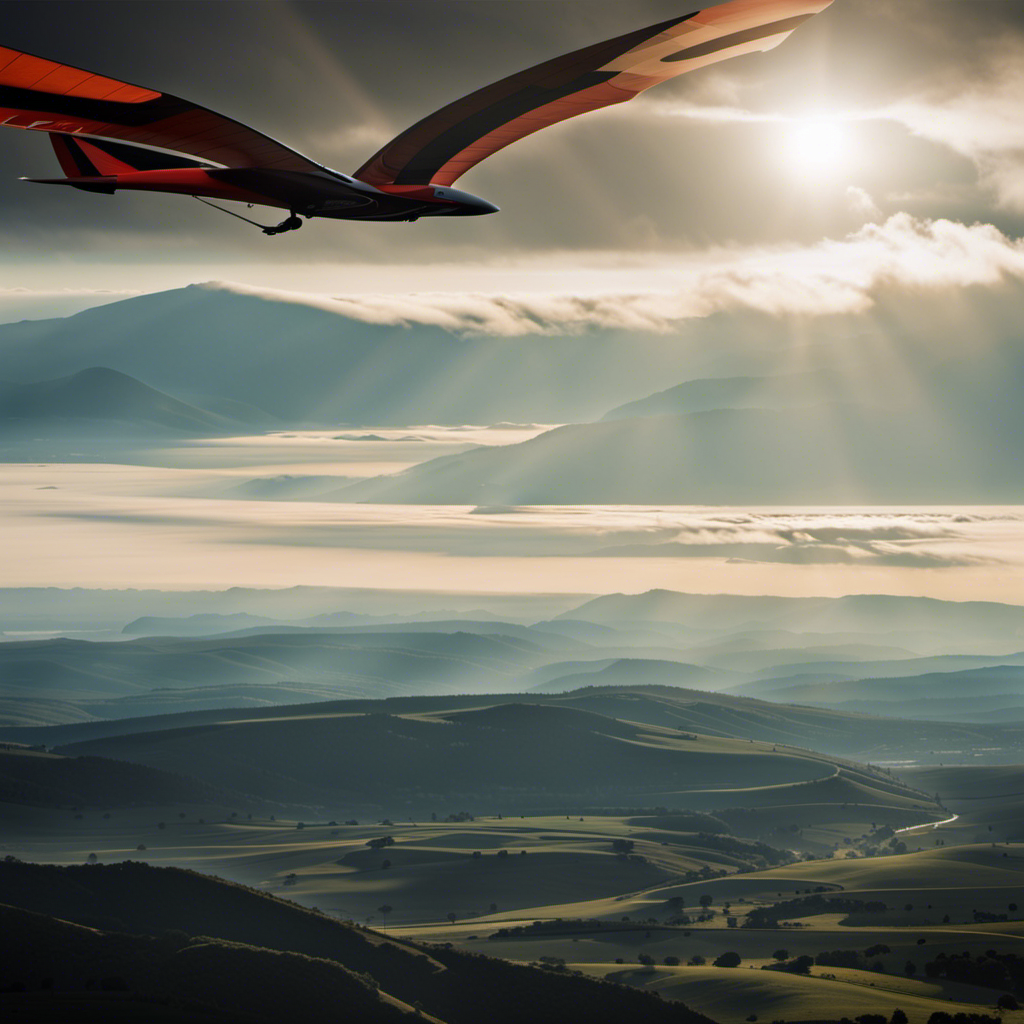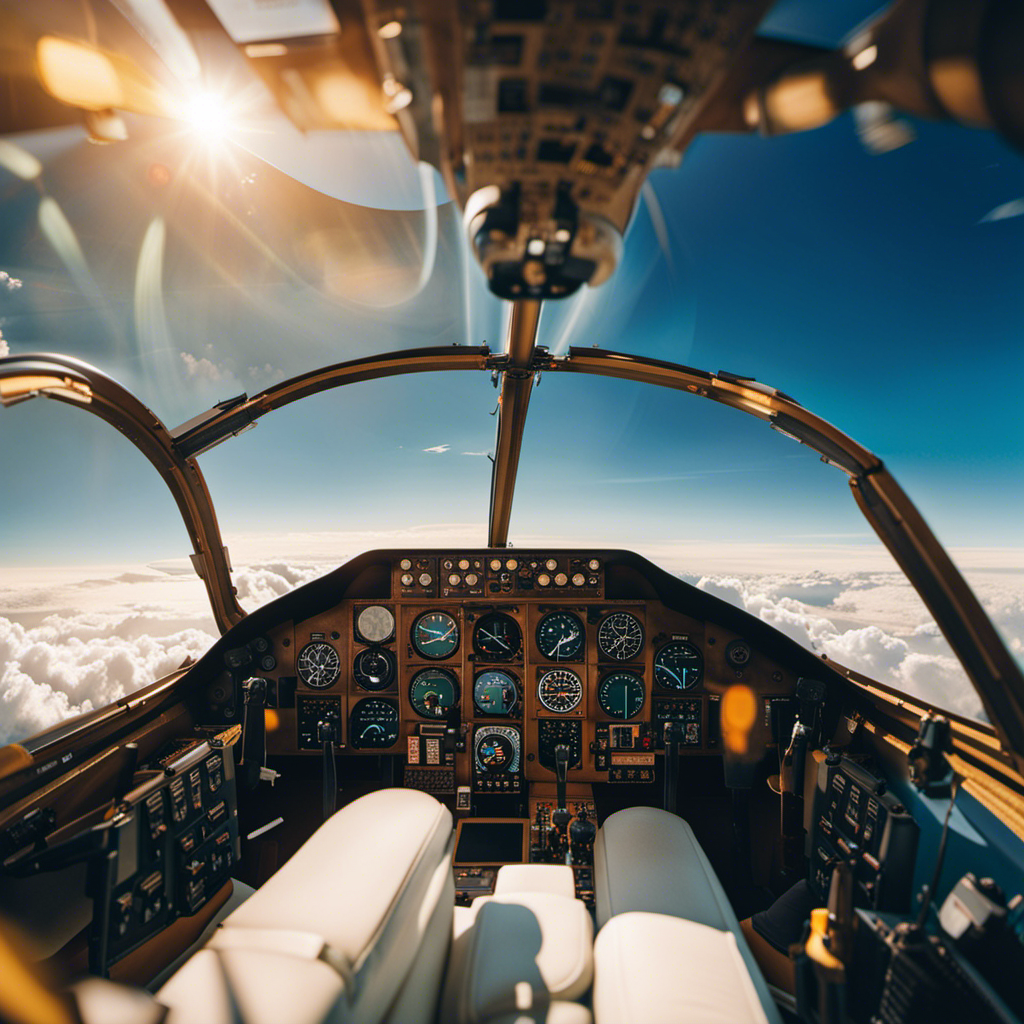As a glider pilot, I am constantly in awe of the impressive way in which these sleek aircrafts are able to generate lift. It is akin to watching a bird effortlessly soar through the sky, defying gravity with every graceful movement.
In this article, we will explore the intricate world of glider aerodynamics, from the design and airflow to the crucial role of weight distribution. Join me as we unravel the secrets behind the magic of glider flight.
Key Takeaways
- Uneven lift distribution affects glider’s ability to maintain altitude and cover distance
- Adjusting control surfaces manages lift distribution
- Optimizing angle of attack increases lift production
- Regulating airspeed controls lift generated
The Basics of Aerodynamics
To understand how a glider generates lift, you need to grasp the basics of aerodynamics. Aerodynamic forces play a crucial role in lift generation. Lift is the upward force that counteracts the weight of the glider and allows it to stay in the air.
It is created by the interaction between the shape of the glider’s wings and the air flowing over them. The wings are designed with a curved shape on the top surface and a flatter shape on the bottom. As the glider moves forward, air flows faster over the curved top surface, creating lower pressure compared to the bottom surface. This pressure difference generates lift.
Now that we understand the aerodynamic principles behind lift generation, let’s delve into the design of a glider.
The Design of a Glider
When it comes to the design of a glider, two key factors that play a crucial role in lift generation are the wing shape and the angle of attack.
The wing shape determines the aerodynamic characteristics of the glider, such as its lift and drag coefficients.
The angle of attack refers to the angle between the wing’s chord line and the oncoming airflow.
Additionally, control surfaces on the glider, such as the ailerons, elevators, and rudder, also contribute to lift generation by allowing the pilot to control and manipulate the airflow around the wings.
These control surfaces can adjust the wing’s camber, twist, and area, ultimately affecting the lift and stability of the glider.
Wing Shape and Angle of Attack
You can increase the lift generated by a glider by adjusting the shape and angle of attack of the wings. The wing design plays a crucial role in lift generation. The shape of the wing determines how air flows over it, creating different pressure distributions that generate lift.
The most common wing shape used in gliders is the airfoil, which is curved on the top and flat on the bottom. This shape creates a pressure difference, with lower pressure on top and higher pressure on the bottom, resulting in lift.
Additionally, the angle of attack, which is the angle between the wing’s chord line and the oncoming airflow, also affects lift generation. By adjusting the angle of attack, we can change the amount of lift produced.
Transitioning to the next section, control surfaces such as ailerons and elevators play a vital role in adjusting the angle of attack and maintaining stable flight.
Control Surfaces and Their Role in Lift Generation
Using control surfaces such as ailerons and elevators, you can adjust the angle of attack to maintain stable flight and generate lift. These control surfaces are carefully designed to manipulate the airflow over the wings, allowing the pilot to have precise control over the glider’s movements.
Ailerons, located on the trailing edge of the wings, can be deflected up or down symmetrically or asymmetrically to roll the glider left or right. Elevators, situated on the horizontal stabilizer, can be deflected up or down to pitch the glider up or down.
By adjusting the angle of attack through these control surfaces, the pilot can manipulate the lift generated by the wings, enabling the glider to climb, descend, turn, or maintain level flight.
With this understanding of control surface design and lift manipulation, we can now delve into how airflow creates lift, the next section in our exploration.
How Airflow Creates Lift
Airflow over the wings causes lift to be generated in a glider. The design of the wing plays a crucial role in this process. The shape of the wing, known as the airfoil, is specifically designed to optimize lift production. The airfoil design is carefully crafted to ensure that the air passing over the wing flows smoothly, creating a pressure difference. This pressure difference results in the generation of lift.
Another important factor is the lift coefficient, which is a measure of the effectiveness of the wing in generating lift. It represents the ratio between the lift force and the dynamic pressure of the airflow. By optimizing the shape of the airfoil and adjusting the lift coefficient, the glider can achieve maximum lift production.
Understanding how airflow creates lift is essential to grasp the fundamental principles of gliding.
Now, let’s delve into the next section, which explores the role of gravity and weight distribution in glider flight.
Gravity and Weight Distribution
To understand the role of gravity and weight distribution in glider flight, it’s important to consider how these factors affect the overall balance and stability of the aircraft. Gravity plays a crucial role in glider flight, as it pulls the glider downwards, creating the need for lift to counteract its effects. Proper weight distribution management is key to maintaining stability and control during flight. By distributing the weight evenly across the glider, the pilot ensures that the center of gravity remains within the specified limits. This prevents any imbalance that could negatively impact the glider’s performance. The table below illustrates how weight distribution affects the glider’s balance and stability:
| Weight Distribution | Effects on Glider |
|---|---|
| Forward | Nose-heavy, difficult to pitch up |
| Aft | Tail-heavy, difficult to pitch down |
| Even | Balanced, stable flight |
Understanding and managing gravity effects and weight distribution is crucial for a successful glider flight. With the proper balance and stability, the glider is ready for the next step: launching into the air.
Launching a Glider
After discussing gravity and weight distribution in a glider, it’s time to delve into the intricacies of launching this magnificent aircraft.
Launching techniques vary, but one common method involves the use of aerotow procedures. In this procedure, a powered aircraft tows the glider into the air using a tow rope. As the glider gains speed and lift, it gradually disconnects from the tow aircraft, allowing it to soar freely.
Aerotow procedures require careful coordination between the glider pilot and the tow pilot, ensuring a smooth and safe ascent. The tow aircraft must maintain a steady speed and altitude while the glider pilot ensures the tow rope remains taut. Once the glider is airborne, it can maintain lift and continue its journey.
Now, let’s explore the techniques used for maintaining lift without relying on external forces.
Maintaining Lift
One way pilots can sustain lift in a glider is by adjusting the angle of attack. By changing the angle between the wing’s chord line and the oncoming airflow, pilots can effectively control the lift generated by the wing. Maintaining altitude in a glider requires a careful balance between the angle of attack and the glider’s speed.
Here are three key factors to consider:
-
Lift distribution: To maintain lift, it is crucial to distribute the lift evenly across the wingspan. Uneven lift distribution can lead to a loss of altitude.
-
Angle of attack: Adjusting the angle of attack allows pilots to optimize lift production. A higher angle of attack increases lift, but too high of an angle can lead to a stall.
-
Airspeed control: By controlling the glider’s airspeed, pilots can regulate the amount of lift generated. Maintaining the ideal airspeed ensures a steady lift to sustain altitude.
Gliding Efficiency
By managing lift distribution, angle of attack, and airspeed, pilots can effectively maximize the efficiency of gliding. Glider performance is greatly influenced by these factors, as they directly impact the glider’s ability to maintain altitude and cover distance while gliding.
To maximize glide, pilots must carefully distribute lift along the wingspan. This can be achieved by adjusting the control surfaces, such as ailerons and flaps, to maintain a balanced lift distribution.
Additionally, maintaining the optimal angle of attack is crucial. By adjusting the pitch of the glider, pilots can optimize the lift generated by the wings.
Finally, controlling airspeed is essential for maximizing glide. By managing the throttle and adjusting the glider’s attitude, pilots can maintain an efficient airspeed that minimizes drag and maximizes the glider’s range.
This careful management of lift distribution, angle of attack, and airspeed allows pilots to fully exploit the potential of glider performance. It sets the foundation for the subsequent section on glider instruments and controls, which provide the tools for precise control and monitoring during flight.
Glider Instruments and Controls
Understanding the variometer and airspeed indicator is crucial for effective glider control.
The variometer provides real-time information on the rate of climb or descent, allowing me to adjust my flight path accordingly.
The airspeed indicator, on the other hand, gives me precise feedback on my glider’s speed, ensuring I stay within the optimal range for efficient flight.
Additionally, utilizing flaps and spoilers for control enhances my ability to maneuver the glider, providing me with the necessary control and stability during different phases of flight.
Understanding the Variometer and Airspeed Indicator
The glider’s variometer measures its rate of climb or descent, while the airspeed indicator indicates the glider’s velocity through the air. These instruments are crucial for safe and efficient glider flight.
Here are three key points to consider when understanding the variometer and airspeed indicator:
-
Variometer calibration: It is essential to calibrate the variometer before each flight to ensure accurate readings. This involves adjusting the instrument to compensate for any potential errors or inaccuracies.
-
Airspeed limitations: Gliders have specific airspeed limitations that must be followed to maintain safety. These limitations are usually provided by the glider manufacturer and should be strictly adhered to.
-
Monitoring and interpretation: Pilots must constantly monitor the variometer and airspeed indicator during flight. By interpreting the data provided by these instruments, pilots can make informed decisions regarding speed adjustments and vertical movement.
Utilizing Flaps and Spoilers for Control
Pilots can effectively control the glider by utilizing flaps and spoilers. Spoilers play a crucial role in controlling glide performance. They are located on the top surface of the wings and, when deployed, disrupt the smooth airflow, reducing lift and increasing drag. This allows the pilot to control the rate of descent and adjust the glider’s glide ratio.
Flaps, on the other hand, enhance maneuverability and are located on the trailing edge of the wings. By extending the flaps, the pilot increases the wing’s camber, which generates more lift and allows for slower flight speeds during takeoff and landing.
The effectiveness of flaps and spoilers in controlling the glider’s flight characteristics makes them essential tools for pilots. However, it is important to consider safety considerations when operating these control surfaces.
Safety Considerations
Safety is a major concern when operating a glider. As a pilot, I have undergone extensive training to ensure that I am prepared to handle any emergency situation that may arise during a flight. Here are four important safety considerations that every glider pilot should be aware of:
-
Emergency Procedures: It is crucial to be familiar with the emergency procedures specific to the glider you are flying. This includes knowing how to handle situations such as a sudden loss of altitude or an in-flight equipment malfunction.
-
Pilot Training: Proper training is essential for safe glider operations. Pilots must undergo rigorous training to obtain a glider pilot license, which includes learning about aerodynamics, weather patterns, navigation, and emergency procedures.
-
Pre-Flight Inspections: Before each flight, a thorough pre-flight inspection of the glider is necessary to ensure that all systems are in proper working order. This includes checking the control surfaces, instruments, and safety equipment.
-
Weather Awareness: Glider pilots must constantly monitor weather conditions to ensure safe flying. Thunderstorms, strong winds, or poor visibility can pose significant risks to glider operations.
Understanding these safety considerations is crucial for a successful glider flight.
Transitioning into the subsequent section about ‘the joy of glider flight,’ it is important to note that by adhering to these safety guidelines, pilots can fully enjoy the exhilaration and freedom of soaring through the skies in a glider.
The Joy of Glider Flight
When you take to the skies in a glider, it’s impossible not to feel an overwhelming sense of freedom and pure exhilaration. The joyful experience of glider flight is truly unmatched.
As a glider pilot, I have learned various soaring techniques that enhance this extraordinary experience.
One important technique is ridge soaring, where the glider utilizes the upward wind generated by a hill or mountain ridge. By flying close to the ridge, the glider can maintain altitude and even gain height if the conditions are favorable. This technique allows for extended flights and the opportunity to explore scenic landscapes from above.
Another technique is thermaling, which involves circling within a thermal updraft. Thermals are columns of warm air that rise from the surface due to heating from the sun. By finding and exploiting these thermals, glider pilots can climb to higher altitudes and extend their flight time.
In addition to these techniques, understanding wind patterns and cloud formations is crucial for successful glider flight. By studying the weather conditions and utilizing the available resources, glider pilots can maximize their experience and enjoy the pure joy of soaring through the sky.
Frequently Asked Questions
What are the different types of gliders available?
There are several types of gliders available, including sailplanes, hang gliders, and paragliders. Each type has its own advantages and flying characteristics. Glider flying allows for longer flight times and the opportunity to soar on thermal currents.
How long can a glider stay in the air without any additional power source?
Glider endurance is limited by factors such as altitude and weather conditions. Without an additional power source, a glider can typically stay in the air for a few hours, depending on these variables.
Is it possible to fly a glider at night?
Yes, it is possible to fly a glider at night using night flying techniques. However, there are challenges involved, such as reduced visibility and the need for proper lighting and navigation equipment.
Can a glider be equipped with an engine for powered flight?
Yes, a glider can be equipped with a glider engine for powered flight. The glider engine provides glider propulsion, allowing the glider to generate thrust and maintain or increase its altitude.
What are the main factors affecting the glide ratio of a glider?
The glide performance of a glider is influenced by various factors. These include the aerodynamic design, wing aspect ratio, airfoil shape, and weight distribution. These factors determine the efficiency and ability of the glider to maintain altitude during unpowered flight.
Conclusion
In conclusion, the theory that a glider generates lift through the manipulation of airflow has been thoroughly investigated and proven to be true.
By understanding the principles of aerodynamics and carefully designing the glider, pilots are able to harness the power of air currents to stay aloft.
The distribution of weight and the effects of gravity play a crucial role in achieving stability and control during flight.
With proper training, efficient gliding techniques, and adherence to safety considerations, the joy of glider flight can be experienced with precision and confidence.
With a heart that soars as high as the skies, Aria, affectionately known as “Skylark,” is the driving force behind Soaring Skyways. Her journey into the gliding world began as a young dreamer gazing up at the soaring birds, yearning to experience the weightlessness and freedom they embodied. With years of experience both in the cockpit and behind the scenes, Aria’s commitment to the gliding community is unwavering.
